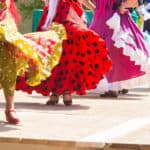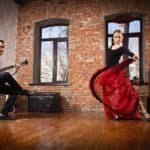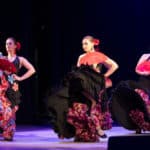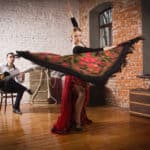Flamenco dance is a Spanish folk dance considered to be one of the “Masterpieces of the Oral and Intangible Heritage of Humanity” by UNESCO. This “Hispanic folk dance” is said to have originated from a region known as Andalusia located in southern Spain. It is said that this style of dancing was first developed using various folk music traditions that existed in the southern coast of Spain as a template. In addition, according to the book “Las Cartas Marruecas” written by Jose Cadalso, this dance is said to have been first performed in year 1774. Furthermore, this Spanish dance form has over the years gained popularity worldwide, and hence as of today it is also taught in non-Hispanic countries.
a. History and origin of Flamenco dance:
Historically speaking, the Andalusia region in southern Spain during the 17th century was essentially a melting pot wherein there was an influx of large number of migrants belonging to various cultures. It is during this period that the music and dance traditions prevailing in Andalusia began undergoing radical changes. These fundamental changes included the incorporation of elements belonging to migrant cultures such Jewish, Greek, Roman, Moorish etc into local music and dance. It was then from these changes incorporated in the local culture that a dance style called “Flamenco” eventually emerged and was then developed.
b. Costumes used in the Flamenco dance:
The costume used by a Flamenco dancer (female) is known as the “Traje De Flamenca”. This attire is basically is a colourful tight fitting dress that includes a skirt and a top which comprise of ruffles. In addition, this costume also includes a shawl known as “Manton De Manilla” which is worn over the shoulders. Furthermore, the performer also ties her hair in the form of bun which is then decorated with flowers.
c. Music involved in the Flamenco dance:
The musical instrument involved in this dance form is the guitar also known as “Flamenco guitar or Toque”. In addition, to music, song (i.e. Cante) also plays a major role in this dance style. Furthermore, the singer of the “Cante” is also known as “Cantaor”.
d. Training availability and the technique involved in the Flamenco dance:
The basic technique of this dance form basically revolves around the expressive use of arms and rhythmic tapping of the feet. However, this dance comprises of number different styles, and they are as follows:
- Gitano Flamenco: In this style the arms are usually curved around the head and body. In addition, it also involves rhythmic tapping of the feet in complete sync with the music.
- Flamenco Puro: Very similar to the Gitano style it is always performed by a single dancer. In addition, this style is based more on improvisation than specific choreography.
- Classical Flamenco: Regularly used by flamenco dance companies in Spain, this style involves little or no hip movements while the body is tightly held together.
- Modern Flamenco: This style is extremely technical and requires years of studying to actually master it. Furthermore, this style basically lays high emphasis on lightening quick footwork. In addition, this style may also involve the use of props such as castanets, shawls, and fans.
- Flamenco Nuevo: Recently developed, this style lays high emphasis on choreography rather than improvisations. In addition, men usually perform bare chested while, women wear plain jersey dresses. Furthermore, props such as shawls, fans etc may be used.
Since this dance form has gained popularity rapidly over the years there are training centres/schools that are now available in many non-Hispanic countries that include the United States of America and Japan. In fact, in Japan more academies that teach flamenco are available than in Spain itself.






